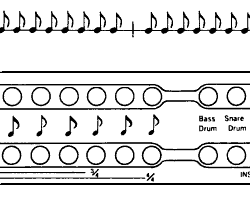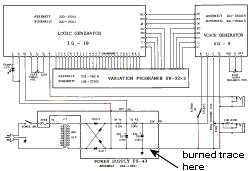LAUGHTON ELECTRONICS |
|
Contagious: was this synth's failure due to associated equipment? |
|
 |
This article describes a strange repair and a follow-up with lethal implications. |
|
A Drum Synthesizer I'd repaired was returned by the customer as “not working.” Needless to say, I'd successfully tested the unit when I completed the repair, so what was the explanation? The mystery deepened when I bench-tested the unit again — and again got a successful result! But after some muttering and head-scratching I eventually noticed that the synth would power down if I unplugged the signal output audio patch cord going to the amp I was using! Very strange. Why would unplugging an audio cable cut the synth power off? With no patch cable connected, I was able to trace down a previously undiscovered fault on the power supply board. One of the copper traces on the power supply circuit board was completely burned off. The pieces began to fall into place. One side of the burned trace still had a connection to the synth chassis, and the chassis connects to the safety ground, the third prong on the unit's power cord. The other side of the burned trace connects to the audio circuit board and to the synth's output jack. The output jack ties to the amplifier input (via the shield on the patch cord) and the input jack goes to the amp chassis. The amp chassis connects to the third prong on the amp's power cord. And the third prong of the amp of course ties to the third prong of the synth, assuming properly grounded receptacles are used. That's what I call a circuitous circuit! But DC was able to flow as if the destroyed trace were still intact. Curiouser and curiouser That explained a lot, but it also unearthed (so to speak) another mystery. It was easy to repair the burned copper trace. But what had created the fault? Sometimes you see damage like that as a result of a lightning strike, or a mis-routed high-power speaker connection. But the most likely culprit is ordinary 115V AC mains power. Although I knew the drum synth was properly repaired at last, my next move was to contact the customer and quiz him regarding the gear he was using with his synth. He brought in his [name-brand] mixing board, and upon removing the cover and inspecting the interior I discovered a remarkable short-circuit. A small steel nut had fallen loose from its screw and had lodged between the bare metal chassis and one of the live AC power connections. The condition was potentially deadly. It was now apparent what had occurred. The nut allowed AC to connect to the mixer chassis, and the mixer safety ground was inoperative at the time — perhaps due to use of an AC extension with no ground prong. But the "hot" mixer found a path to ground via the patch cable. The copper trace vaporized because it was part of the path from the synth's output jack to its (properly-grounded) chassis. It was chilling to contemplate. Besides the drum synth, a human being could've gotten fried as well. In hindsight I'm certainly glad I didn't simply fix the synth and leave matters at that! Tracing the problem to a separate piece of equipment was what allowed us to neutralize the threat. |
|
|
|
 |
|

